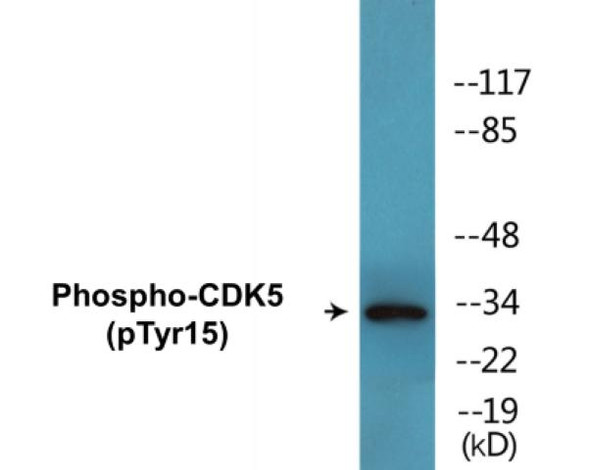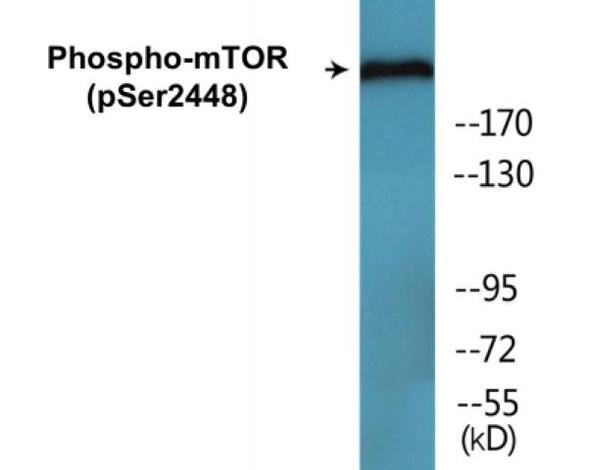Description
CDK5 (Phospho-Tyr15) Cell-Based ELISA Kit
The CDK5 (Phospho-Tyr15) Cell-Based ELISA Kit is a convenient, lysate- free, high throughput and sensitive assay kit that can monitor CDK5 phosphorylation and expression profile in cells. The kit can be used for measuring the relative amounts of phosphorylated CDK5 in cultured cells as well as screening for the effects that various treatments, inhibitors (ie. siRNA or chemicals), or activators have on CDK5 phosphorylation.
How does our CDK5 (Phospho-Tyr15) Fluorometric Cell-Based ELISA Kit work?
Qualitative determination of CDK5 (Phospho-Tyr15) concentration is achieved by an indirect ELISA format. In essence, CDK5 (Phospho-Tyr15) is captured by CDK5 (Phospho-Tyr15)-specific primary (1°) antibodies while Dye 1-conjugated and Dye 2-conjugated secondary (2°) antibodies bind the Fc region of the 1° antibody. Through this binding, the dye conjugated to the 2° antibody can emit light at a certain wavelength given proper excitation, hence allowing for a fluorometric detection method. Due to the qualitative nature of the Cell-Based ELISA, multiple normalization methods are needed:
| 1. | A monoclonal antibody specific for human GAPDH is included to serve as an internal positive control in normalizing the target RFU values. |
| 2. | An antibody against the nonphosphorylated counterpart of CDK5 (Phospho-Tyr15) is also provided for normalization purposes. The RFU values obtained for non-phosphorylated CDK5 can be used to normalize the RFU value for phosphorylated CDK5. |
CDK5 (Phospho-Tyr15) Fluorometric Cell-Based ELISA Kit -Information
| Product Name: | CDK5 (Phospho-Tyr15) Fluorometric Cell-Based ELISA Kit |
| Product Code/SKU: | FBCAB00055 |
| Description: | The CDK5 (Phospho-Tyr15) Fluorometric Cell-Based Phospho ELISA Kit is a convenient, lysate-free, high throughput and sensitive assay kit that can monitor CDK5 (Phospho-Tyr15) protein phosphorylation and expression profile in cells. The kit can be used for measuring the relative amounts of phosphorylated CDK5 (Phospho-Tyr15) in cultured cells as well as screening for the effects that various treatments, inhibitors (ie. siRNA or chemicals, or activators have on CDK5 phosphorylation. |
| Dynamic Range: | > 5000 Cells |
| Detection Method: | Fluorometric |
| Storage/Stability: | 4°C/6 Months |
| Reactivity: | Human, Mouse, Rat |
| Assay Type: | Cell-Based ELISA |
| Database Links: | Gene ID: 1020, UniProt ID: Q00535, OMIM #: 123831, Unigene #: Hs.647078 |
| Format: | Two 96-Well Plates |
| NCBI Gene Symbol: | CDK5 |
| Sub Type: | Phospho |
| Target Name: | Phospho-CDK5 (Tyr15) |
Kit Principle
Figure: Schematic representation of Assay Genie Cell-Based Fluorometric ELISA principle
Kit components | Quantity |
| 96-Well Black Cell CultureClear-Bottom Microplate | 2 plates |
| 10X TBS | 24 ml |
| Quenching Buffer | 24 ml |
| Blocking Buffer | 50 ml |
| 15X Wash Buffer | 50 ml |
| Primary Antibody Diluent | 12 ml |
| 100x Anti-Phospho Target Antibody | 60 µl |
| 100x Anti-Target Antibody | 60 µl |
| Anti-GAPDH Antibody | 110 µl |
| Dye-1 Conjugated Anti-Rabbit IgG Antibody | 6 ml |
| Dye-2 Conjugated Anti-Mouse IgG Antibody | 6 ml |
| Adhesive Plate Seals | 2 seals |
Additional equipment and materials required
The following materials and/or equipment are NOT provided in this kit but are necessary to successfully conduct the experiment:
- Fluorescent plate reader with two channels at Ex/Em: 651/667 and 495/521
- Micropipettes capable of measuring volumes from 1 µl to 1 ml
- Deionized or sterile water (ddH2O)
- 37% formaldehyde (Sigma Cat# F-8775) or formaldehyde from other sources
- Squirt bottle, manifold dispenser, multichannel pipette reservoir or automated microplate washer
- Graph paper or computer software capable of generating or displaying logarithmic functions
- Absorbent papers or vacuum aspirator
- Test tubes or microfuge tubes capable of storing ≥1 ml
- Poly-L-Lysine (Sigma Cat# P4832 for suspension cells)
- Orbital shaker (optional)
Kit Protocol
This is a summarized version of the kit protocol. Please view the technical manual of this kit for information on sample preparation, reagent preparation and plate lay out.
| 1. | Seed 200 µl of desired cell concentration in culture medium into each well of the 96-well plates. For suspension cells and loosely attached cells, coat the plates with 100 µl of 10 µg/ml Poly-L-Lysine (not included) to each well of a 96-well plate for 30 minutes at 37°C prior to adding cells. |
| 2. | Incubate the cells for overnight at 37°C, 5% CO2. |
| 3. | Treat the cells as desired. |
| 4. | Remove the cell culture medium and rinse with 200 µl of 1x TBS, twice. |
| 5. | Fix the cells by incubating with 100 µl of Fixing Solution for 20 minutes at room temperature. The 4% formaldehyde is used for adherent cells and 8% formaldehyde is used for suspension cells and loosely attached cells. |
| 6. | Remove the Fixing Solution and wash the plate 3 times with 200 µl 1x Wash Buffer for 3 minutes. The plate can be stored at 4°C for a week. |
| 7. | Add 100 µl of Quenching Buffer and incubate for 20 minutes at room temperature. |
| 8. | Wash the plate 3 times with 1x Wash Buffer for 3 minutes each time. |
| 9. | Dispense 200 µl of Blocking Buffer and incubate for 1 hour at room temperature. |
| 10. | Wash 3 times with 200 µl of 1x Wash Buffer for 3 minutes each time. |
| 11. | Add 50 µl of Primary Antibody Mixture P to corresponding wells for CDK5 (Phospho-Tyr15) detection. Add 50 µl of Primary Antibody Mixture NP to the corresponding wells for total CDK5 detection. Cover the plate with parafilm and incubate for 16 hours (overnight) at 4°C. If the target expression is known to be high, incubate for 2 hours at room temperature. |
| 12. | Wash 3 times with 200 µl of 1x Wash Buffer for 3 minutes each time. |
| 13. | Add 50 ul of Secondary Antibody Mixture to corresponding wells and incubate for 1.5 hours at room temperature in the dark. |
| 14. | Wash 3 times with 200 µl of 1x Wash Buffer for 3 minutes each time. |
| 15. | Read the plate(s) at Ex/Em: 651/667 (Dye 1) and 495/521 (Dye 2). Shield plates from direct light exposure. |
| 16. | Wash 3 times with 200 µl of 1x Wash Buffer for 5 minutes each time. |
CDK5 (Phospho-Tyr15) - Protein Information
| UniProt Protein Function: | CDK5: a protein kinase of the CDK family. Unlike other members of this family, it is not activated by cyclins but by p35 (CDK5R1) and p39. An important regulator of neuronal positioning during brain development. May also play a role in synaptogenesis and neurotransmission. Substrates include TAU, MAP2, NF-H and -M, Nudel, PDE6, beta-catenin, amphyphysin, dynamin I, synapsin 1, Munc-18, and NMDA receptor 2A. Plays a role in myogenesis, haematopoietic cell differentiation, spermatogenesis, insulin secretion, and lens differentiation. Implicated in the pathology of neurofibrillary tangles and formation of senile plaques, hallmarks of Alzheimer?s disease. Induces tau phosphorylation and aggregation and neurofibrillary tangle deposition and neurodegeneration in in vitro and in vivo animal models. Brain samples from Alzeimer?s pateints show elevated CDK5 activity. |
| UniProt Protein Details: | Protein type:Protein kinase, CMGC; Kinase, protein; Cell cycle regulation; Protein kinase, Ser/Thr (non-receptor); EC 2.7.11.1; CMGC group; CDK family; CDK5 subfamily; CDK/CDK5 subfamily Chromosomal Location of Human Ortholog: 7q36 Cellular Component: axon; cell junction; cell soma; cytoplasm; cytosol; dendrite; growth cone; membrane; neuromuscular junction; nucleoplasm; nucleus; plasma membrane; postsynaptic density Molecular Function:acetylcholine receptor activator activity; cyclin-dependent protein kinase activity; ErbB-2 class receptor binding; ErbB-3 class receptor binding; kinase activity; protein binding; protein kinase activity; protein serine/threonine kinase activity; tau-protein kinase activity Biological Process: axon extension; cell proliferation; negative regulation of proteolysis; negative regulation of transcription, DNA-dependent; neurite development; neuron apoptosis; neuron differentiation; neuron migration; oligodendrocyte differentiation; peptidyl-serine phosphorylation; phosphorylation; positive regulation of neuron apoptosis; regulation of apoptosis; regulation of macroautophagy; regulation of synaptic plasticity; synaptic transmission; synaptic vesicle endocytosis; synaptic vesicle exocytosis; synaptogenesis Disease: Lissencephaly 7 With Cerebellar Hypoplasia |
| NCBI Summary: | This gene encodes a proline-directed serine/threonine kinase that is a member of the cyclin-dependent kinase family of proteins. Unlike other members of the family, the protein encoded by this gene does not directly control cell cycle regulation. Instead the protein, which is predominantly expressed at high levels in mammalian postmitotic central nervous system neurons, functions in diverse processes such as synaptic plasticity and neuronal migration through phosphorylation of proteins required for cytoskeletal organization, endocytosis and exocytosis, and apoptosis. In humans, an allelic variant of the gene that results in undetectable levels of the protein has been associated with lethal autosomal recessive lissencephaly-7. Alternative splicing results in multiple transcript variants. [provided by RefSeq, May 2015] |
| UniProt Code: | Q00535 |
| NCBI GenInfo Identifier: | 4033704 |
| NCBI Gene ID: | 1020 |
| NCBI Accession: | Q00535.3 |
| UniProt Secondary Accession: | Q00535,A1XKG3, |
| UniProt Related Accession: | Q00535 |
| Molecular Weight: | 29,544 Da |
| NCBI Full Name: | Cyclin-dependent-like kinase 5 |
| NCBI Synonym Full Names: | cyclin dependent kinase 5 |
| NCBI Official Symbol: | CDK5 |
| NCBI Official Synonym Symbols: | LIS7; PSSALRE |
| NCBI Protein Information: | cyclin-dependent-like kinase 5 |
| UniProt Protein Name: | Cyclin-dependent-like kinase 5 |
| UniProt Synonym Protein Names: | Cell division protein kinase 5; Serine/threonine-protein kinase PSSALRE; Tau protein kinase II catalytic subunit; TPKII catalytic subunit |
| Protein Family: | CDK5RAP1-like protein |
| UniProt Gene Name: | CDK5 |
| UniProt Entry Name: | CDK5_HUMAN |







